You’re Probably Loading Your Dishwasher Wrong
Thinking outside the box can help you get a better performance out of your dishwasher—and maybe even spare you from ending up with broken glasses and those dreaded water spots.
By Mike Rampton

There’s a lot of emotion in a dishwasher. Watching someone else stack dishes in yours can be a deeply confusing experience—there’s relief that you’re not the one doing it, but also sheer annoyance over the fact that they’re probably loading it incorrectly.
There’s so much someone else can drop the ball on that chances are you probably prefer to do it yourself. But the thing is, you’re probably doing it wrong too—at least as far as experts are concerned.
“The biggest thing to think about when you’re loading the dishwasher is if the water’s not gonna hit it, it’s not going to get clean,” Carolyn Forté, executive director of the Good Housekeeping Institute’s Home Care and Cleaning Lab, said in a recent interview on HuffPost’s “Am I Doing It Wrong?” podcast.
The Right—And Wrong—Way to Load Glasses
When it comes to how to load a dishwasher, Forté claims that the biggest mistake folks tend to make involves their glasses. She recommends putting them against the tines in a dishwasher, not over them. (Tines, for the uninitiated, are the bars sticking up on the upper and lower racks that hold and separate your dinnerware.) While it certainly can feel like it makes sense to place glasses over those tines, in doing so, you could end up damaging the material.
Plus, there’s another reason why it’s a good idea to position cups this way and make sure your glasses are leaning outwards, away from the middle of the machine. If you keep them at an angle, it helps ensure water runs off more easily after the cleaning process, making gross water spots a lot less likely to form.
How To Load Forks, Spoons, and Knives
Cutlery is a whole other ball game and can be a source of uncertainty as well. If you’re stumped about whether to load flatware up or down in a basket, you’re not the only one. “Years ago, you’d just have a basket in the bottom rack with all the different sections, and that’s really where most of the confusion came from—up? Down? Whatever,” Forté said.
Forté claims that if your dishwasher has a top tier, you could line up your spoons, forks, and knives on that upper flat rack and clean them that way, while they’re laying down. But if you’re using the basket on the bottom tier, there is a correct way to go about it.
“Spoons should alternate up and down, because you don’t want two spoons to nest. If two spoons nest each other, then one’s not gonna get any [water],” she said. If you’re opting not to wash them by hand, knives should be placed in the basket with their blades down. Forks, on the other hand, should have their tines up. (Just be sure to grab forks by their handles when it’s time to unload the dishwasher; if your hands are dirty, grabbing the handles helps prevent cross-contamination.)
Other Dishwasher Hacks To Keep In Mind
Another major issue? Overcrowding. Pros suggest you’re better off stacking things well, running the machine twice and having clean dishes than trying to shove too much in there and ending up with broken, unclean dishes. Speaking of loading, aim to stack plates, bowls, and other items from front to back and at an angle, with their dirty sides facing the center of the dishwasher. Keep plastic bowls, plates, and storage containers on the top tier, as the heating element at the bottom of the machine can melt and warp the material. Separating forks, spoons, and knives into groups within a basket can also save you time and energy when you go to unload things.
Hardcore dishwasher-heads have all sorts of hacks and tips to get the most out of the appliance. Many opt to scrape dishes before loading them—the chemicals in detergent may react negatively with food—but will avoid rinsing them off, as dishwashers are more energy-efficient than hand-washing. There are even items that have nothing to do with the kitchen—everything from golf balls to beach toys to hairbrushes—that can go through a dishwasher, as well as some real wildcard options, like oven mitts, sponges, and so on.
And, once a cycle finishes, a carefully placed dishtowel draped over the door can absorb a lot of the steam in the machine, meaning your dishes will come out far dryer than they otherwise would. You’ll have clean, dry glasses that you’ll want to, well, raise a glass to.
Read More Live Smarter Articles:
manual